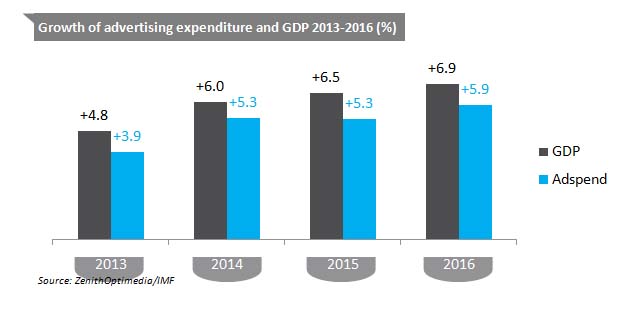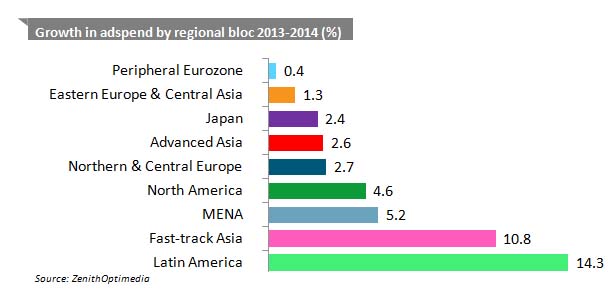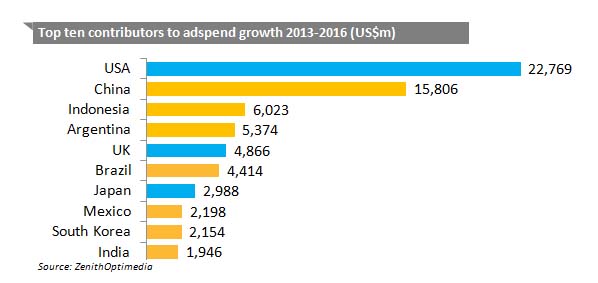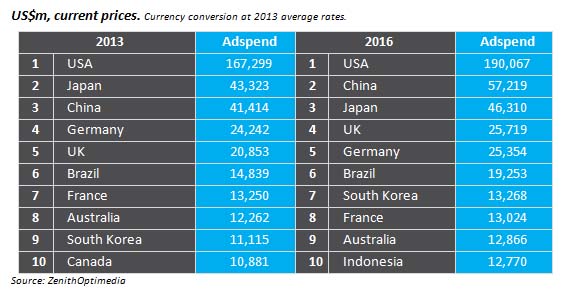



Digital ad tech to drive adspend growth
share on
The rapid development of digital advertising technology will help the global advertising market grow 5.3% in 2014, up from 3.9% in 2013. Growth will remain strong over the next two years, staying at 5.3% in 2015 and rising to 5.9% in 2016, according to ZenithOptimedia’s new Advertising Expenditure Forecasts.
The company predicts global adspend to grow 5.3% to reach US$523 billion over the course of this year. Internet advertising is the fastest-growing medium, forecasted to expand by 17.1% this year, as improving digital advertising technology makes internet advertising cheaper and more effective. This growth is being driven by a wider spectrum of companies than traditional media, including digital specialists, tech companies, and direct advertisers.
New technology is improving most areas of internet advertising. Improved advertising formats – such as the ‘Rising Stars’ identified by the Interactive Advertising Bureau in the US – are making internet display more interactive and attention-grabbing, with consumers more likely to view, remember and interact with them than older formats. Meanwhile programmatic buying is evolving to allow more sophisticated and efficient targeting of display audiences, and is becoming better at delivering premium, brand-building experiences, said the report.
ZenithOptimedia forecasts traditional display advertising to grow at an average of 15.8% a year between 2013 and 2016, up from 12.3% a year between 2010 and 2013. Social media display is growing much faster – at an average of 29.9% a year between 2013 and 2016 –with advertisers exploiting the explosion of mobile social media use and the ability to target across desktop and mobile. As online video extends to smartphones, tablets, gaming consoles and connected TV sets, it is providing advertisers with a wealth of new opportunities to connect with consumers: Online video advertising is forecasted to grow by 24.2% a year between 2013 and 2016, said a note in the report.
Paid search is being boosted by the adoption of tools that have proved themselves in display, making it more addressable, as platforms give advertisers more control over where, when and to whom their ads are exposed, and also allowing the re-targeting of consumers who have previously visited an advertiser’s website with custom copy. "We expect these improvements to help paid search maintain an average growth rate of 14.0% a year over the next three years, up marginally from 13.5% over the previous three years," said ZenithOptimedia.
Forecast by leading advertising markets
Despite the rapid growth of the Rising Markets*, the US is still the biggest contributor of new ad dollars to the global market. "Between 2013 and 2016 we expect the US to contribute 26% of the US$87 billion that will be added to global adspend. After the US, however, the biggest contributors are much younger and more dynamic. China comes second, accounting for 18% of additional ad dollars over this period, followed by Indonesia and Argentina, accounting for 7% and 6% respectively," said the report.
Seven of the ten largest contributors will be Rising Markets, contributing 44% of new adspend over the next three years. "Overall, we forecast Rising Markets to contribute 59% of additional ad expenditure between 2013 and 2016, and to increase their share of the global market from 34% to 38%," said the report.
In 2013 China was the third-largest ad market in the world, behind the USA and Japan. China has been narrowing the gap with Japan rapidly over the last few years, and this year we expect it to overtake Japan to become the world’s second-largest ad market.
The UK, currently the fifth-largest ad market, is growing much faster than Germany, the fourth largest. In 2013 the UK expanded by US$1,009m, while Germany expanded by just US$53m.
"We expect the disparity to be even greater this year, at US$1,325m. By 2016 we expect the UK to overtake Germany to become the world’s fourth-largest ad market," said ZenithOptimedia.
Indonesia was the thirteenth-largest ad market in 2013, but is rising quickly up the rankings. The market is expected to be tenth by 2016, pushing out Canada, which will fall to eleventh. South Korea is also expected to rise from ninth to seventh, pushing France and Australia down one place each.
Global advertising expenditure by medium
The internet is still the fastest growing medium, growing 17.1% in 2013, with a forecast of an average of 16% annual growth from 2014 to 2016.
Display is the fastest-growing sub-category, with 21% annual growth forecast to 2016, thanks partly to the rapid rise of social media advertising, which is growing at 30% a year, including traditional display (such as banners), online video and social media.
"Improved advertising formats are making internet display more interactive and attention-grabbing, while programmatic buying is evolving to allow more sophisticated targeting of display audiences ever more efficiently."
Measurement agencies are investing in research that should measure consumers’ exposure to traditional display ads more accurately, and track their exposure to video ads across desktop computers, tablets and television screens. Some broadcasters are starting to trade packages that include both online video and television spots; online video is also starting to be sold by programmatic buying, providing advertisers with more control and better value. The study forecasts online video to grow at 24% a year for the rest of the forecast period.
Paid search is expected to grow at an average rate of 14% a year to 2016, driven by continued innovation from the search engines, including the display of richer product information and images within ads, better localisation of search results, and mobile ad enhancements like click-to-call and geo-targeting. Paid search is also becoming addressable, as platforms give advertisers more control over where, when and to whom their ads are exposed.
Online classified has been subdued since the downturn in 2009; after the initial shift from print to digital, classified publishers have had to compete with new paid-for and free alternatives for matching buyers and sellers.
share on
Free newsletter
Get the daily lowdown on Asia's top marketing stories.
We break down the big and messy topics of the day so you're updated on the most important developments in Asia's marketing development – for free.
subscribe now open in new window




